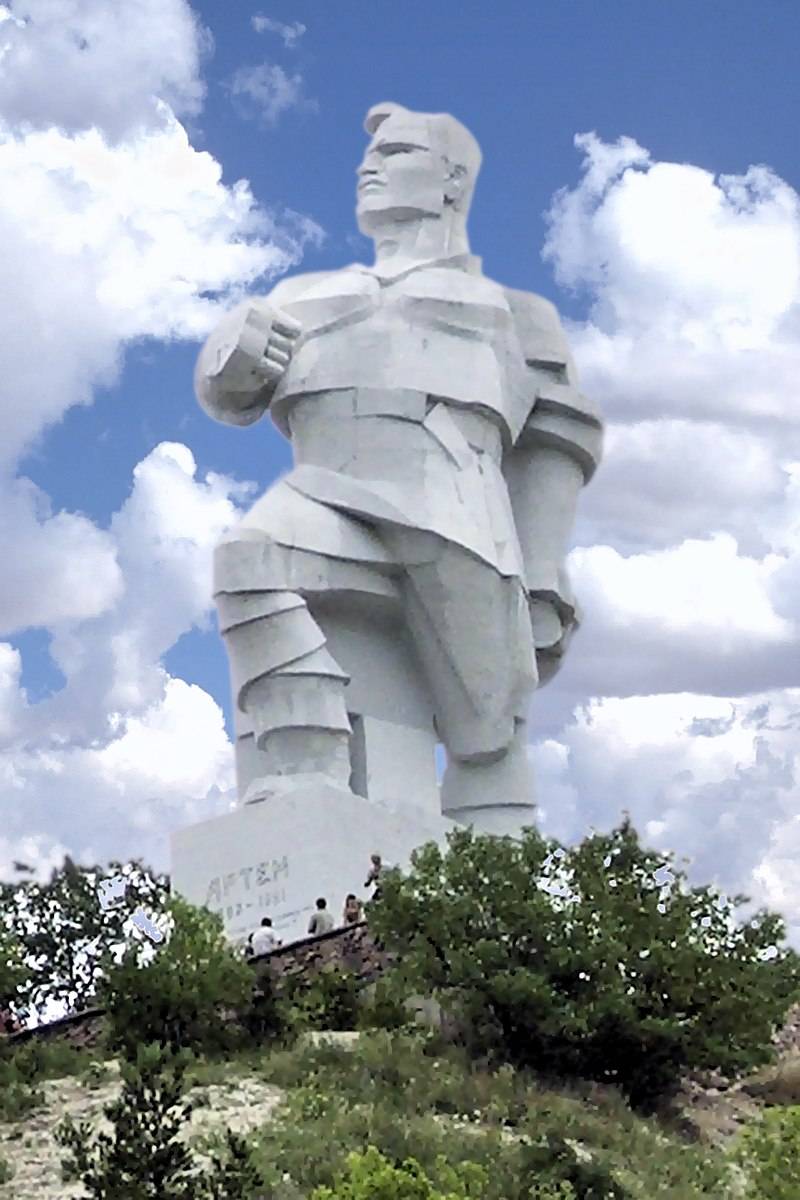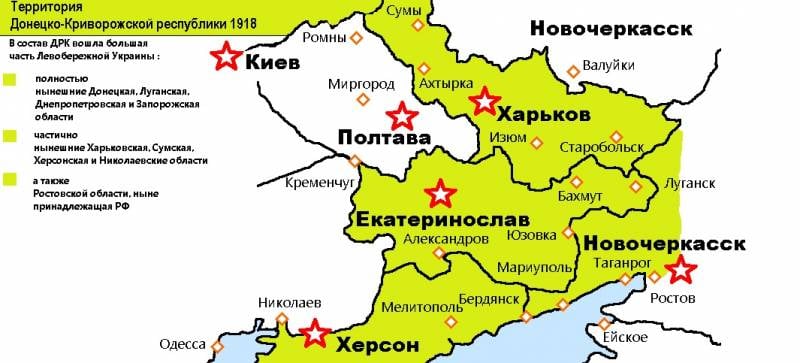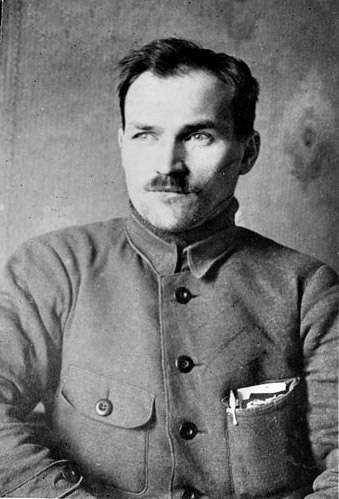Donetsk response

Monument to Artyom - a monument in the city of Svyatogorsk, built in 1927
Donetsk issue
The Russian ukraine-outskirts was never united, it consisted of several historical regions that differed in historical development, national and social composition of the population, economic potential. Donbass was one of these regions. The edge of coal and steel. The Donetsk region could not remain aloof from the ongoing processes in Little Russia after the collapse of the Russian Empire.
The Donetsk region arose in the second half of the XNUMXth century as an industrial center of Russia. There were ore, coking coal and asbestos - the three main components for smelting metal. There was also the port of Mariupol, through which steel and cast iron were exported. Plus the initiative of forward-thinking entrepreneurs. This led to an industrial boom. The recent Wild Field has changed radically. A new industrial center of Russia emerged. Thousands of former peasants quickly became miners, miners, metallurgists. The work was hard, but the wages were high. Dangerous, hard and productive work, plus a certain degree of freedom, created a special type of Russian person. This is how the Donbass appeared - persistent, stubborn and freedom-loving Russian people.
Naturally, the Donets Basin could not remain aloof from the Russian Troubles. In the summer of 1917, the Provisional Government in Petrograd and the Central Rada negotiated the future borders of an autonomous Ukraine (there was no talk of full independence yet). The question arose about the future of Donbass. Kyiv, of course, wanted to get the region, understanding its economic importance. Not without reason, already in the years of “independence” after the collapse of the USSR in 1991, Donbass and the economic regions of the east of the former Ukrainian SSR fed the whole of Ukraine.
On the other hand, there was an understanding that Donbass is a completely different land. So, a local industrialist and one of the leaders of the Council of Congresses of Miners of the South of Russia, von Ditmar, noted:
As a result, in the course of negotiations with the Rada, the Kerensky government left the nationalists only five provinces of the former empire - Volyn, Kyiv, Podolsk, Chernihiv and Poltava.
When the Provisional Government fell and the Bolsheviks seized power, the appetites of the Rada increased. The Kyiv regime again began to lay claim to the Donbass.
Donetsk response
Meanwhile, the positions of the Donbass residents, who did not want to obey the Rada, strengthened. They were led by a bright revolutionary, the Bolshevik Fedor Andreevich Sergeev (better known as "Comrade Artyom"). A close friend of Sergei Kirov and still little known at that time, Joseph Stalin.
The regional organization of the Bolsheviks of the Donetsk-Krivoy Rog region, on the one hand, supported the idea of convening the All-Ukrainian Congress of Soviets. But, on the other hand, the idea of creating the Donetsk-Krivoy Rog Soviet Republic (DKSR) was discussed in the Kharkiv city and Donetsk-Kryvyi Rih regional Soviets.
On November 17, 1917, the chairman of the Military Revolutionary Committee (VRK), Artyom, supported the idea of the Mensheviks and Socialist-Revolutionaries for freedom of self-determination of the regions, against their "annexation" by the Rada. It was proposed to create an autonomous Donetsk region independent of the Kyiv Rada. The Donetsk-Kryvyi Rih basin with Kharkov was supposed to remain part of Russia as a special single administrative-self-governing region. As a result, the Donetsk-Krivoy Rog region was considered as a territory that was not part of Ukraine. This resolution was supported by the workers and employees of the Kharkov junction of the Southern Railways, the Bolsheviks of Kharkov.
On December 11-12, 1917, the All-Ukrainian Congress of Soviets was held in Kharkov, which proclaimed Ukraine a Republic of Soviets, announced the overthrow of the Rada, the establishment of federal ties with Soviet Russia. The Central Executive Committee (CEC) of the Soviets was elected, the People's Secretariat was established - the first Soviet government of Ukraine. A third of the elected CEC were representatives of the Soviets of the Donetsk-Krivoy Rog region. Comrade Artyom joined the government.
In response to further claims by the Rada, the 4th Congress of Soviets of Workers' and Soldiers' Deputies of the Donetsk Basin and the Krivoy Rog District was convened in Kharkov. Donbass did not want to yield to the leaders of the "Ukrainian bourgeois republic." On February 12, 1918, the creation of the Donetsk-Kryvyi Rih Republic was proclaimed in the Metropol Hotel (translated as "capital").
The republic included the territories of Kharkov and Yekaterinoslav provinces (in its entirety), part of Krivoy Rog of the Kherson province, part of the districts of the Taurida province (up to the Crimean Isthmus) and the adjacent industrial regions of the Don Cossacks, the city of Shakhty and along the line of the Rostov-Likhaya railway. Now these are the current Donetsk, Lugansk, Dnepropetrovsk and Zaporozhye regions, as well as partially Kharkov, Sumy, Kherson, Nikolaev and Rostov regions. The capital was Kharkov, then Lugansk. The government (Sovnarkom) was headed by Sergeev (Artyom).

The fall of the DKSR
In March 1918, the German army moved to Kharkov and the Donbass. The 1st Donetsk Army was formed in the DKSR. Thousands of volunteers from Kharkov, Yuzovka, Lugansk, Yekaterinoslav and other places joined it. Several armored trains were equipped at the Lugansk Locomotive Plant. However, the forces of the young Soviet Army could not resist the Germans. The Bolsheviks retreated.
The Donetsk army covered the North-Donetsk railway. On April 28, 1918, the Donetsk army left Lugansk. The entire territory of the DKSR was occupied by the Germans. The Donetsk army, together with the 5th army of Voroshilov, went to Tsaritsyn. On August 27, 1918, Soviet Russia and Germany signed an additional treaty, one of the clauses of which Donbass was declared temporarily occupied by German territory.
At the end of 1919, the Red Army drove Denikin out of the Donbass. The Donetsk province was created. At first, the Donetsk province lived according to the laws of Soviet Russia. However, later Donbass was included in the Ukrainian SSR. Supporters of the revival of the DKSR were quickly merged into various places. Artyom since November 1920 - Executive Secretary of the Moscow Committee of the RCP (b), then Chairman of the Central Committee of the All-Russian Union of Miners, member of the All-Russian Central Executive Committee.
Sergeev died under mysterious circumstances on July 24, 1921, during the testing of Abakovsky's air car. Later, a version appeared that the Trotskyists eliminated him. Artyom was indeed a zealous opponent of Trotsky. But, obviously, he was a dangerous opponent for the Ukrainian nationalists who “repainted” as Bolsheviks.
Sergeev's son Artyom Fedorovich was taken into his family by Stalin. He lived with Vasily, graduated from the artillery school. Passed the Great Patriotic War. He rose to the rank of Major General of Artillery.
Thus, the Donbass, an industrial region with a predominantly Russian population, was included in the Ukrainian SSR. This was beneficial to the Trotskyists and nationalists who dreamed of the destruction of the Russian world. They tried to Ukrainianize the Donetsk region. But back in 2001, about 75% of the inhabitants of the region considered Russian as their native language.
In 2014, Donbass launched a popular uprising against the Nazi, Russophobic policies of the Kyiv regime. This is the real heart of Russian civilization. They try to kill him, demolish entire cities from the face of the earth, but the Russians stand to the death. There is nowhere to retreat - behind Rus'!

1st Chairman of the Council of People's Commissars of the DKSR Fedor Andreevich Sergeev
Information